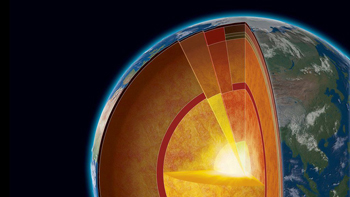Tokyo, Jan 12: Japanese scientists say that silicon is likely the mystery element in the Earth's inner core, claiming progress on solving one of the planet's deepest secrets.
 Consensus has long been that the centre of the planet is composed of about 85 percent iron and 10 percent nickel, with sulphur, oxygen and silicon prime candidates for the other five percent.
Consensus has long been that the centre of the planet is composed of about 85 percent iron and 10 percent nickel, with sulphur, oxygen and silicon prime candidates for the other five percent.
But geophysicist Eiji Ohtani at Tohoku University in northern Japan and his research team suggest that silicon is the most likely candidate.
Ohtani's team conducted experiments on iron-nickel alloys mixed with silicon, subjecting them in the lab to the kinds of high temperatures and pressure found in the inner core.
It discovered that the data for the mixed material observed with X-rays matched seismic data- namely, sound velocity, or seismic waves- obtained for the inner core.
"Our latest experiments suggest that the remaining five percent of the inner core is composed mostly of silicon," Ohtani told AFP on Wednesday.
He said that the finding helps understand whether the Earth's surface was rich in oxygen in its early formation before photosynthesis began as oxygen has been another potential candidate for the mystery element in the Earth's inner core.
Ohtani cautioned that more work needs to be done to confirm his findings on silicon.
Some scientists say that if the Earth's inner core contains silicon then it means the rest of the planet must have been relatively oxygen rich at the time of its formation, because oxygen that they believe existed when the planet was formed was not confined to the inner core.
But if the mystery element in the core is oxygen then the rest of the Earth was oxygen-poor in the beginning.
Ohtani said he does not think oxygen now exists in the inner core, citing the difficulty for silicon and oxygen to co-exist in the same place.
"But it doesn't necessarily mean the rest of the planet was oxygen rich because there is a possibility that oxygen did not exist as an element of the Earth at its formation in the first place."
The Earth is believed to be made up of three main layers: the solid outer layer where creatures including humans live, the mantle which is made up of hot magma and other semi-solid materials, and the core at the centre.
The core comprises an outer layer of liquid iron and nickel, and an inner layer -- a hot dense ball of mostly iron.
Ohtani presented his team's work at a meeting in December of the American Geophysical Union in San Francisco, and is preparing to submit a research paper to a peer-reviewed scientific journal.
The presentation used a method similar to that applied by his team in a study published in February last year in the peer-reviewed journal Science Advances.





Comments
Add new comment